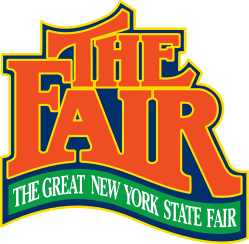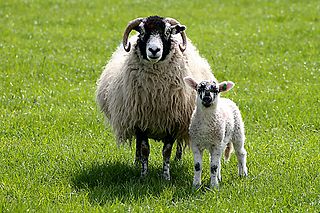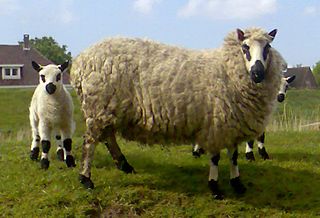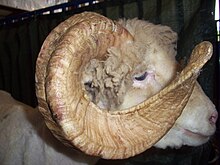
Wool is the textile fibre obtained from sheep and other mammals, especially goats, rabbits, and camelids. The term may also refer to inorganic materials, such as mineral wool and glass wool, that have properties similar to animal wool.

The North Ronaldsay or Orkney is a breed of sheep from North Ronaldsay, the northernmost island of Orkney, off the north coast of Scotland. It belongs to the Northern European short-tailed sheep group of breeds, and has evolved without much cross-breeding with modern breeds. It is a smaller sheep than most, with the rams (males) horned and ewes (females) mostly hornless. It was formerly kept primarily for wool, but now the two largest flocks are feral, one on North Ronaldsay and another on the Orkney island of Auskerry. The Rare Breeds Survival Trust lists the breed as a priority on its 2021–2022 watchlist, and they are in danger of extinction, with fewer than 600 registered breeding females in the United Kingdom.
The Perendale is a breed of sheep developed in New Zealand by Massey Agricultural College for use in steep hill situations. The breed is named after Sir Geoffrey Peren, and it achieves its aims by being the offspring of Romney ewes and Cheviot rams with sturdy legs. It is raised primarily for meat.

Karakul or Qaraqul is a breed of domestic fat-tailed sheep which originated in Central Asia. Some archaeological evidence points to Karakul sheep being raised there continuously since 1400 BC.

The New York State Fair, also known as the Great New York State Fair, is a 13-day showcase of agriculture, entertainment, education, and technology. With midway rides, concessionaires, exhibits, and concerts, it has become New York's largest annual event and an end-of-summer tradition for hundreds of thousands of families from all corners of the state. The first fair took place in Syracuse in 1841, and took permanent residence there in 1890. It is the oldest and one of the largest state fairs in the United States, with over one million visitors annually.

The Border Leicester is a British breed of sheep. It is a polled, long-wool sheep and is considered a dual-purpose breed as it is reared both for meat and for wool. The sheep are large but docile. They have been exported to other sheep-producing regions, including Australia and the United States.

Swaledale is a breed of domestic sheep named after the Yorkshire valley of Swaledale in England. They are found throughout the more mountainous areas of Great Britain, but particularly in the Yorkshire Dales, County Durham, and around the pennine fells of Cumbria.
West Friendship is a semi-rural unincorporated community in western Howard County, Maryland, United States. West Friendship is located at the junction of Interstate 70 and Maryland Route 32. Frederick Road is a main thoroughfare.

The Romney, formerly called the Romney Marsh sheep but generally referred to by the local farmers as the Kent, is a breed of sheep originating in England. The Romney is a "long-wool" breed recognized in England by 1800. Exported to other continents, the Romney is an economically important sheep breed, especially to the sheep-meat and wool export trades of New Zealand.

The New York State Sheep and Wool Festival is an annual gathering of fiber-arts enthusiasts in the United States that draws approximately 30,000 visitors and more than 300 vendors. It is held at the Dutchess County Fairgrounds in Rhinebeck, New York.

Fiber festivals bring together producers and vendors of mostly animal fibers, such as wool, qiviut, camelid, mohair, and angora. Other fibers include silk, linen, and some synthetic fibers. The festival caters to knitters, spinners, felters, crocheters, and dyers in the United States. Attendees learn and see different materials, techniques, and patterns. Fiber festivals also provide a meeting place for people who otherwise know one another only from Internet lists and blogs.

The Shetland Islands of Scotland have long had their own distinct animal breeds, due to the remoteness of the archipelago. Below is a list of Shetland's domesticated animals.

Alpaca fleece is the natural fiber harvested from an alpaca. There are two different types of alpaca fleece. The most common fleece type comes from a Huacaya. Huacaya fiber grows and looks similar to sheep wool in that the animal looks "fluffy". The second type of alpaca is Suri and makes up less than 10% of the South American alpaca population. Suri fiber is more similar to natural silk and hangs off the body in locks that have a dreadlock appearance. While both fibers can be used in the worsted milling process using light weight yarn or thread, Huacaya fiber can also be used in a woolen process and spun into various weight yarns. It is a soft, durable, luxurious and silky natural fiber.

Romanov is a breed of domestic sheep originating from the Upper Volga region in Russia. These domestic sheep got the name Romanov from the town of the same name. In the 18th century, these sheep were first noticed outside of Russia. Soon after, they were imported to Germany and then to France. In 1980, 14 ewes and 4 rams were bought by the Canadian government and were quarantined for 5 years. After the testing, some of the Romanov breed was brought into the United States. The distribution of this unique breed is worldwide. This breed is raised primarily for meat.

Minnesota's Shepherd's Harvest Festival is the largest sheep and wool festival in Minnesota.

The Kerry Hill is a breed of domestic sheep originating in the county of Powys in Wales. It derives its name from the village of Kerry (Ceri), near Newtown. Kerry Hill sheep have a distinctive and unique coloration, with a white face bearing black markings around the mouth, ears, and eyes. Both rams and ewes are polled. Their wool is white, and their legs are white with black markings. First mentions of the breed date back to the early 19th century, and today it is distributed throughout the United Kingdom, Ireland, the Netherlands, Germany and Denmark. Though still not very numerous, the breed was removed from the records of the Rare Breeds Survival Trust watchlist in 2006. This breed is primarily raised for meat.

Sheep or domestic sheep are domesticated, ruminant mammals typically kept as livestock. Although the term sheep can apply to other species in the genus Ovis, in everyday usage it almost always refers to domesticated sheep. Like all ruminants, sheep are members of the order Artiodactyla, the even-toed ungulates. Numbering a little over one billion, domestic sheep are also the most numerous species of sheep. An adult female is referred to as a ewe, an intact male as a ram, occasionally a tup, a castrated male as a wether, and a young sheep as a lamb.

The Llanwenog is a breed of domestic sheep originating in Wales. It was developed in the 19th century from the Llanllwni, the Shropshire, Welsh Mountain, and Clun Forest breeds. The Llanwenog's native locale is the Teifi Valley, in western Wales, but it has since spread into other areas. The breed association was formed in 1957. Llanwenogs have black faces and medium-length wool. They have a docile temperament and are known for their profligacy in lambing. The breed has a very placid temperament, is easily handled, easily contained and is well suited to stress free inwintering if necessary. This has important consequences for the health of both the animal and its keeper. This breed is raised primarily for meat.

The Dalesbred is a breed of domestic sheep originating in England. Derived from the Swaledale and Scottish Blackface breeds, the Dalesbred is a northern hill breed distributed in the Yorkshire Dales and into Lancashire. The Dalesbred is genetically distinct from the other northern hill breeds, the Herdwick and Rough Fell.
Ivory is an unincorporated community located at the northwest tip of Howard County, Maryland, United States. It is located between modern Glenelg and West Friendship.

















